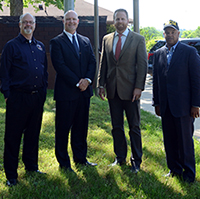[callout template=”cvsacallout1″]

CVSA kicks off 2016 International Roadcheck on June 7 in Maryland. Pictured left to right: Dr. Robert Molloy, NTSB; Collin Mooney, CVSA; Blair Anderson, NHTSA; Scott Darling, FMCSA.
[/callout]
Inspectors are conducting driver and vehicle safety inspections on large trucks and buses day and night during the Commercial Vehicle Safety Alliance’s (CVSA) 72-hour International Roadcheck, June 7-9, 2016. Commercial motor vehicles and their drivers are checked at inspection sites and roving patrol locations along major highways across North America.
CVSA kicks off the 29th annual International Roadcheck on June 7, 2016, at the West Friendship Weigh and Inspection Station in West Friendship, Maryland. The kickoff event includes speakers from CVSA, the Federal Motor Carrier Safety Administration (FMCSA), National Highway Traffic Safety Administration (NHTSA) and the National Transportation Safety Board (NTSB).
“International Roadcheck is a snapshot of what the 13,000 CVSA-certified inspectors across North America do every day, 4 million times a year: inspect commercial drivers and vehicles for compliance with safety regulations in an effort to save lives,” said CVSA President Maj. Jay Thompson with the Arkansas Highway Police. “We hold this annual three-day inspection and enforcement blitz to not only shine a spotlight on the proactive and preemptive work of our inspectors, but to highlight the many drivers and motor carriers who understand the importance of commercial motor vehicle safety maintenance and safe driver behavior and practices on our roadways.”
During International Roadcheck, inspectors primarily conduct the North American Standard Level I Inspection, which is the most thorough roadside inspection. It is a 37-step procedure that includes examinations of both the driver and vehicle. Drivers are asked to provide their license, endorsements, and hours-of-service documentation, and they will be checked for seat belt usage. Inspectors will also be attentive to any apparent impairment by alcohol and/or drugs. The vehicle inspection includes checking braking system, cargo securement, coupling devices, exhaust systems, frames, fuel systems, driveline/driveshaft components, lights, steering mechanisms, suspensions, tires, van and open-top trailer bodies, wheels, rims and hubs, and windshield wipers. Additional items for buses include emergency exits, electrical cables and systems in the engine and battery compartments, and seating.
Each year, International Roadcheck places special emphasis on a category of violations. The special emphasis for 2016 International Roadcheck is tire safety (i.e., measuring the tire tread depth, checking the tire pressure, checking to make sure that no items are lodged between dual tires and examining the overall condition of the tire to make sure that no deep cuts or bulges exist in the sidewalls of the tire). While checking a vehicle’s tires is always part of roadside inspections, CVSA is highlighting tire safety as a reminder to drivers and carriers.
Since its inception in 1988, roadside inspections conducted during Roadcheck have numbered over 1.4 million. It also provides an opportunity to educate industry and the general public about the importance of safe commercial vehicle operations and the North American Standard Inspection Program. International Roadcheck is sponsored by CVSA, North America’s leading commercial vehicle safety-enforcement organization, with participation by FMCSA, Canadian Council of Motor Transport Administrators and the Secretariat of Communications and Transportation in Mexico.
